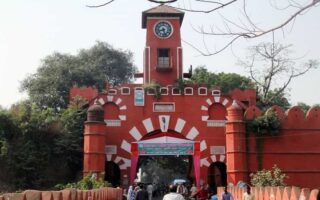The various historical places in India are as unique as a God’s creation can be. These historical sites, ever since they were created or discovered, have been the centre of attraction. People visit these sites in large numbers for various purposes. The Udayagiri Caves in Madhya Pradesh too have been a place where tourists arrive in large numbers every year to look at one of the most exquisite group of caves in India.
Location
The Udayagiri Caves are located near the town of Vidisha, Madhya Pradesh.
History
The cave group is said to have been created during the 4th and 5th century, when the emperors of the Gupta Empire were ruling the region. Apart from the caves, there are ruined structures, fortifications, inscriptions, water supply systems, rock-shelters and other historical remains at the site. This site holds immense archaeological, cultural and historical importance.
Structure
During the nineteenth century, Alexander Cunningham, a British archaeologist, numbered the caves. These numbers were replaced with a detailed system of identification implemented by the Department of Archeology. This led to a dispute in the numbering sequence as people noticed that many of the structures do not fit into the criteria of caves. The following caves are usually explored by the visitors due to the inscriptions and sculptures found on the walls and in the interior.
Cave One
This cave features a unique entrance point in the form of a ridge and has been praised by art historians for its four exquisitely carved pillars.
Cave Three
This cave is the first in a bunch of shrines. Walking through the entrance, one can reach an irregular shaped interior. A sculpture of the war God can be seen resting on a partially damaged pedestal.
Cave Four
The fourth cave features two statues and rock-cut pilasters outside and rectangle shaped cellar inside, where a Shivlinga is placed on a pedestal. There is a water channel attached to the plinth, which goes all the way to wall.
Cave Five
The fifth cave of the group is where a figure of God Vishnu can be seen. The figure seen here depicts his Varaha avatar.
Cave Six
Next to the cave five is cave six, which features a T-shaped door that leads to a rock cut chamber. It is said that this cave also housed a Shivlinga, which has gone missing since long. The exterior of the cave features an inscription. One can also see the inscription on the ceiling of the cave which suggests that someone by the name Shivaditya pilgrimaged to this cave.
The guardians at either side of the entrance are considered as some of the most influential works carried out during the Gupta period.
Cave Eight
This cave has been created in the form of a dome-shaped rock and is credited to nature, giving it such unique shape through the erosion of rock slab over centuries. To the entrance, one can see two figures representing the guards. The inner chamber is empty except for an inscription on the rear wall and a carving of lotus flower over the ceiling.
The inscription states that the work was executed by a minister working in the court of Chandragupta II. This is the only record of the presence of a Gupta ruler at any place.
There is a passage beside this cave, which has been altered over time. The worn-out steps suggest that this passage was a water-cascade in the ancient times. The inscriptions found on the walls of this passage are called shell inscriptions. Though these inscriptions are yet to be translated, it is believed that they precede the Gupta Dynasty.
Cave Twelve
One can see a statue of Narasimha, an avatar of Lord Vishnu. There is an inscription in Brahmi script and two sculptures of attendants with the statue.
Cave Thirteen
One can see a reclining figure of Narayana, another avatar of Lord Vishnu. There is another figure in a kneeling position, argued to be of Chandragupta II.
Cave Fourteen
This cave is partially damaged with only two side walls in proper condition. From the entrance, one can enter into a square shaped empty chamber. There is a water channel with a passage through the wall like many other caves.
Eat, Drink, Collect
There are a couple of restaurants in the town that serve meals, snacks and beverages at nominal prices.
Best Time to Visit
The best time to visit Udayagiri Caves and other attractions of Vidisha is during the months of October through March.
How to Reach
Vidisha is connected to several cities of the state and neighboring states through its railway station. The city is located at a distance of 56 kilometres from Bhopal, the state capital, thus making it easier for tourists to reach here through connecting trains. The nearest domestic airport is also at Bhopal with regular flights for Mumbai, Delhi, Raipur, Indore, Chennai and several other cities.
Tourists can also reach Vidisha through regular buses and from thereon, they can commute in tongas, tempos, or private vehicles.
